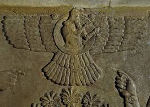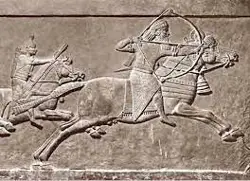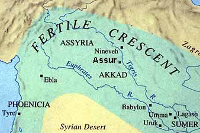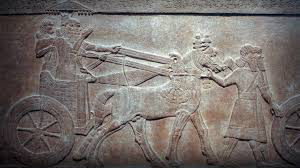The Assyrian Empire
Part 1: Growing into Power The Assyrians were a warlike people who ruled most of the Middle East at one time or another during several centuries in ancient times. 
As Sumer regained control and, in fact, absorbed some territory of its former conqueror, the Akkadians, another power rose to the north of Babylon. This was the Assyrian civilization. The civilization was a power in the area in and around Mesopotamia for more than a century. At its height, the Assyrian Empire stretched from what is now southern Iraq to the Mediterranean coast. 
The Assyrians enjoyed a longstanding reputation as the most efficient and feared military force in the known world. A large, well equipped infantry, made up of archers firing iron-tipped arrows and swordsman wielding iron-forged blades, accompanied a potent cavalry of bow-and-arrow-wielding horsemen and a number of deadly chariot contingents, resulting in an army that conquered an increasing number of neighboring peoples. 
The earliest vestiges of an Assyrian civilization emerged about 2500 B.C. Most prominent among the cities of this ancient civilization for most of its existence was the city of Ashur (sometimes written Assur), which established itself initially as a trading city, northeast of Babylon. The city is said by some sources to have been named after a man named Ashur; other sources say that the people living in the city named it after the god Ashur. A king named Erishum I built a temple to that god in that city about 1900 B.C., and many historians date the founding of the city to this time. Other important cities of mostly Assyrian origin included Ibil, Kalakh, and Nineveh. 
Ashur traded with surrounding cities and civilizations, most notably with the Babylonian-Sumerian civilization and with Anatolia, in what is now Turkey, to the north and west. It was from Anatolia that the Assyrians enjoyed a steady pipeline of iron with which they fashioned large numbers of sturdy weapons. The first well-known Assyrian warrior king was Shamashi Adad I, who ruled from 1813 B.C. to 1791 B.C. and established a buffer zone for the growth of Ashur. The end of his reign coincided with the beginning of the reign of the powerful Amorite king Hammurabi, who significantly reduced Assyrian influence in the region. That king, famous for his set of laws, ruled for a few decades. His successors were unsuccessful in holding on to what he had gained. At the same time, however, the Assyrians were in no position to benefit from the collapse of the Early Babylonian Empire because of a civil war that plagued the area in and around Ashur for many years. Emerging from that conflict was King Adasi, who asserted control in 1726 B.C. and ruled for 20 years or so. As was the fate of others, his reign was followed by a period of conquest. The conquerors this time were from the Kingdom of Mitanni, to the northwest, in eastern Anatolia. The Mittani ruled over Ashur and the rest of Assyria for a few centuries and were themselves reduced by the Hittites, another neighboring tribe. The Assyrians bided their time and took advantage of a reduction in Hittite Next page > Imperial Highs and Lows > Page 1, 2 |
|
Social Studies for Kids
copyright 2002–2025
David White



 power. King Ashur-Uballit I won a great victory and re-established the Assyrian Empire about 1353 B.C. A later king, Adad Nirari I, retook much of the land seized by the Hittites and the Mittani. He then set about making sure that those conquered wouldn't be able to rise up again by removing them from their homes. His son and grandson, Shalmaneser I and Tukulti-Ninurta I, continued this policy and introduced severe punishments for any kind of political or civil unrest. At the same time, such rulers were eager to assimilate the cultures of conquered peoples into the overall Assyrian ethos. Tukulti-Ninurta I composed an epic poem that described his people's victory over the king of Babylon. This victory resulted in the subjugation of that very famous city and the sacking of temples and other sources of wealth. The Assyrian king's ordering of the sacking of the temples angered many of his subjects, including his own son, who arranged for his father's assassination and then succeeded him on the throne. The son was not the uniter or conqueror that the father was and succeeded only in not losing any territory.
power. King Ashur-Uballit I won a great victory and re-established the Assyrian Empire about 1353 B.C. A later king, Adad Nirari I, retook much of the land seized by the Hittites and the Mittani. He then set about making sure that those conquered wouldn't be able to rise up again by removing them from their homes. His son and grandson, Shalmaneser I and Tukulti-Ninurta I, continued this policy and introduced severe punishments for any kind of political or civil unrest. At the same time, such rulers were eager to assimilate the cultures of conquered peoples into the overall Assyrian ethos. Tukulti-Ninurta I composed an epic poem that described his people's victory over the king of Babylon. This victory resulted in the subjugation of that very famous city and the sacking of temples and other sources of wealth. The Assyrian king's ordering of the sacking of the temples angered many of his subjects, including his own son, who arranged for his father's assassination and then succeeded him on the throne. The son was not the uniter or conqueror that the father was and succeeded only in not losing any territory.
